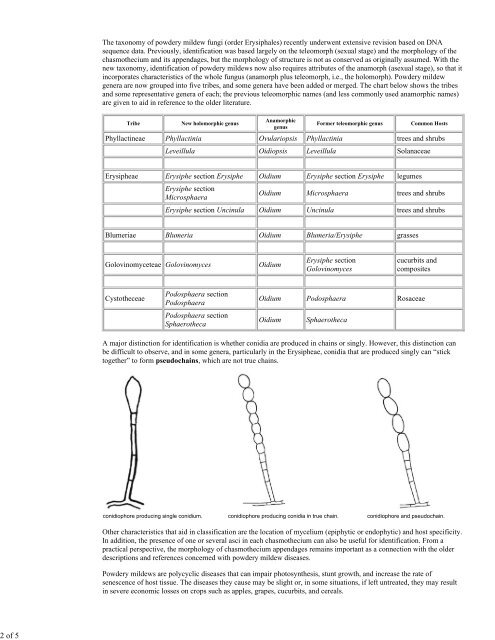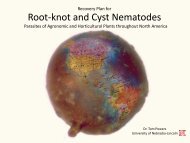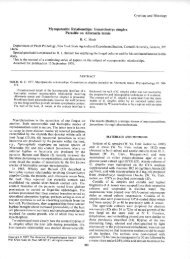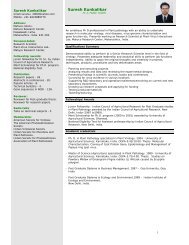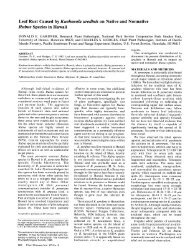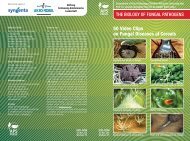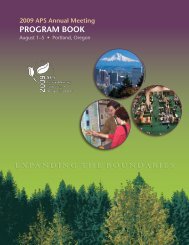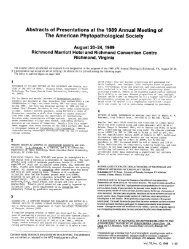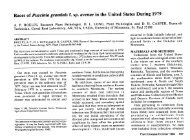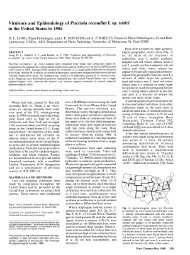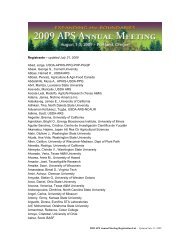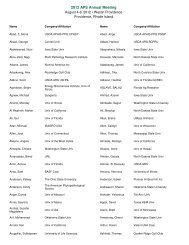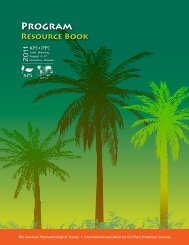Identification of Powdery Mildew Fungi - American ...
Identification of Powdery Mildew Fungi - American ...
Identification of Powdery Mildew Fungi - American ...
Create successful ePaper yourself
Turn your PDF publications into a flip-book with our unique Google optimized e-Paper software.
2 <strong>of</strong> 5<br />
The taxonomy <strong>of</strong> powdery mildew fungi (order Erysiphales) recently underwent extensive revision based on DNA<br />
sequence data. Previously, identification was based largely on the teleomorph (sexual stage) and the morphology <strong>of</strong> the<br />
chasmothecium and its appendages, but the morphology <strong>of</strong> structure is not as conserved as originally assumed. With the<br />
new taxonomy, identification <strong>of</strong> powdery mildews now also requires attributes <strong>of</strong> the anamorph (asexual stage), so that it<br />
incorporates characteristics <strong>of</strong> the whole fungus (anamorph plus teleomorph, i.e., the holomorph). <strong>Powdery</strong> mildew<br />
genera are now grouped into five tribes, and some genera have been added or merged. The chart below shows the tribes<br />
and some representative genera <strong>of</strong> each; the previous teleomorphic names (and less commonly used anamorphic names)<br />
are given to aid in reference to the older literature.<br />
Tribe New holomorphic genus<br />
Anamorphic<br />
genus<br />
Former teleomorphic genus Common Hosts<br />
Phyllactineae Phyllactinia Ovulariopsis Phyllactinia trees and shrubs<br />
Leveillula Oidiopsis Leveillula Solanaceae<br />
Erysipheae Erysiphe section Erysiphe Oidium Erysiphe section Erysiphe legumes<br />
Erysiphe section<br />
Microsphaera<br />
Oidium Microsphaera trees and shrubs<br />
Erysiphe section Uncinula Oidium Uncinula trees and shrubs<br />
Blumeriae Blumeria Oidium Blumeria/Erysiphe grasses<br />
Golovinomyceteae Golovinomyces Oidium<br />
Cystotheceae<br />
Podosphaera section<br />
Podosphaera<br />
Podosphaera section<br />
Sphaerotheca<br />
Erysiphe section<br />
Golovinomyces<br />
cucurbits and<br />
composites<br />
Oidium Podosphaera Rosaceae<br />
Oidium Sphaerotheca<br />
A major distinction for identification is whether conidia are produced in chains or singly. However, this distinction can<br />
be difficult to observe, and in some genera, particularly in the Erysipheae, conidia that are produced singly can “stick<br />
together” to form pseudochains, which are not true chains.<br />
conidiophore producing single conidium. conidiophore producing conidia in true chain. conidiophore and pseudochain.<br />
Other characteristics that aid in classification are the location <strong>of</strong> mycelium (epiphytic or endophytic) and host specificity.<br />
In addition, the presence <strong>of</strong> one or several asci in each chasmothecium can also be useful for identification. From a<br />
practical perspective, the morphology <strong>of</strong> chasmothecium appendages remains important as a connection with the older<br />
descriptions and references concerned with powdery mildew diseases.<br />
<strong>Powdery</strong> mildews are polycyclic diseases that can impair photosynthesis, stunt growth, and increase the rate <strong>of</strong><br />
senescence <strong>of</strong> host tissue. The diseases they cause may be slight or, in some situations, if left untreated, they may result<br />
in severe economic losses on crops such as apples, grapes, cucurbits, and cereals.


